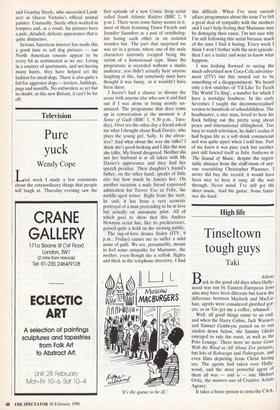Sale-rooms
Rover's return
Peter Watson
When James Christie started his venerable firm, in the days of 18th-century new money, his rooms were the Tramp of their day, where the fashionable 'Upper Ten Thousand' used to gather for gossip and gain. It was also the Garrick of the
'A. Blenheim and a Cavalier King Charles Spaniel, with a Norfolk Terrier, a Cairn and a Manchester Terrier, with a Parrot', by George Armfield, on sale at Christie's
day, for that distinguished actor Sam John- son and Joshua Reynolds were all close friends of Christie, who then owned a stake in the Morning Chronicle, and the four men comprised a sort of mafia that held sway in matters of taste.
Have things changed so much? The sale-rooms of London are again the venue where increasing amounts of new money are enthusiastically exchanged for an ever- increasing variety of second-hand goods, off-loaded as often as not by the gentle- man's club classes, and much of it as overpriced as champagne in Jermyn Street.
Not surprisingly, then, when one stum- bles across a sale this coming week coyly entitled Man's Best Friends, one's pulse quickens, there is a stirring in the loins. In the new Britain, a man's best friend is surely the kind of woman who prefers a Magimix to money? On learning that the stars of the sale include Maud Earl and Mabel Gear the pulse slips on to 'fast forward'. Maud end Mabel sound very new Britain.
Alas, the Man's Best Friends sale is very old Britain. The phrase means what it always did. This is Cruft's week and the lapdogs in the auctions at Bonham's (on Monday) and Christie's, South Kensington (on Wednesday) are not Murdoch journal- ists but spaniels, pugs and pekinese.
If today's auction houses were clubs, the Garrick would not figure. Christie's would be White's, Sotheby's would be Tramp, Phillips the RAC and Bonham's — what? The Women's Institute? No matter, it is Bonham's which has made the running in a number of 'theme' sales held, as is this one, to coincide with another event. It is one of the few sales where the goods on offer at the smaller house are on a par with those of their classier rival and where the catalogue is just as glossy, just as colourful, just as thick.'
That reflects the buoyancy of this sector. This is hardly an area of 'great art' — if anything it is one of the most sentimental fields there is. Embarrassing titles for pictures, such as `Two's Company, Three's a Crowd', or 'Awaiting the Ladyship's Return' abound. Nonetheless, even if the pictures aren't exactly moving, in the sense that a Bellini or a Bacon is moving, for dog-lovers they still give pleasure at prices which are, in this new Britain of ours, very modest. Prices this week start at £200, well below your average libel award, and are not expected to top £25,000.
Lapdogs and sporting dogs (gun dogs, hounds) are the most popular. Working dogs (collies, sheepdogs) are not sought after, despite the new climate. The only exceptions are a husky and a St Bernard in the Christie's sale, both of which have royal connections. `Luska — a • Siberian Sled Dog' is said to have been one of Edward VII's favourite dogs and this, together with the fact that the artist was none other than Maud Earl, accounts for its relatively high estimate of £10,000- £15,000. The St Bernard — 'Sandringham Count' — was a favourite of Queen Alex- andra but comes with a much more modest estimate of £1,00042,000.
The most famous dog in the sale is a champion pekinese, romantically known as 'Yen Chu of Newnham'. He won Cruft's several times, 50 other first prizes and as a. result was rendered immortal, yet again by Mrs Earl (estimate f10,000415,000).
The Bonham's sale has its share of mushy titles — 'He who Pays the Piper Calls the Tune', 'Fish is Cheap Today', `Hide and Seek' — but it has a wider range of breeds: a black and tan terrier, deerhounds, Newfoundlands, a Lancashire heeler, a brindled Great Dane. Bonham's also has the only Landseer on offer this week.
Besides Maud and Mabel, the other first division artists in this field include Cecil Aldin, George Armfield, John Emms, Edward Frederick Holt, Arthur Wardle
and Gourlay Steele, who succeeded Land- seer as Queen Victoria's official animal painter. Unusually, Steele often worked in tempera and, as a result, his pictures have a pale, detailed, delicate appearance that is quite distinctive.
Serious American interest has made this a good time to sell dog pictures — our North American cousins appear to be every bit as sentimental as we are. Living in a country of apartments, and not having many hunts, they have helped set the fashion for small dogs. There is also quite a fad for aggresive dogs — terriers, bulldogs, pugs and mastiffs. No rottweilers as yet but no doubt, in this new Britain, it can't be far off.



















































 Previous page
Previous page